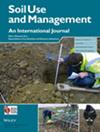Partial substitution of chemical fertilizer by green manure increases succeeding maize yield and annual economic benefit in low-yield cropland in the Yellow River Delta
IF 3.7
3区 农林科学
Q1 SOIL SCIENCE
引用次数: 0
Abstract
Green manures (GM) combined with fertilizer reduction is an efficient measure to alleviate the environmental issues caused by the overapplication of chemical fertilizer. However, both the environmental and economic benefits remain unclear in coastal regions that are affected by both soil salinization and climate change. A field experiment was conducted in low-yield cropland in the Yellow River Delta to explore the effects of green manure rotation combined with fertilizer reduction on the soil environment and economic sustainability. Two GM species, Vicia villosa (HV) and Orychophragmus violaceus (OV), a traditional winter wheat (Wheat), were grown in winter, with a fallow control (Fallow). In the subsequent maize season, three fertilizer rate treatments, a full rate of 600 kg ha−1 compound fertilizer (F100), 85% of the full rate (F85), and 70% of the full rate (F70), were applied in each former treatment. The results indicated that GM return markedly increased soil total N (TN) and P (TP) before the V6 stage of maize (when maize had 6 leaves). The average TN contents of HV and OV increased by 56.9% and 38.5%, respectively, compared with that of Wheat, while the values for TP were 13.6% and 16.9%. Compared with Fallow, the maize yields of HV and OV increased by 25.6% and 13.8%, respectively, while that of Wheat decreased by 9.1%. The average partial fertilizer productivities (PFPs) for HV and OV increased by 25.3% and 14.0% compared with Fallow, while Wheat decreased by 8.9%. The PFPs for F85 and F70 increased by 19.4% and 37.7%, respectively, compared with F100. Reducing the fertilizer rate to 70% in the HV–maize rotation pattern did not reduce but increased the total net profit and rate of return. Thus, HV–maize rotation combined with 30% fertilizer reduction is suggested for sustainable agriculture in this region.用绿肥部分替代化肥提高黄河三角洲低产农田的玉米后继产量和年经济效益
绿肥(GM)与化肥减量相结合是缓解过度施用化肥造成的环境问题的有效措施。然而,在受土壤盐碱化和气候变化双重影响的沿海地区,其环境和经济效益仍不明确。研究人员在黄河三角洲的低产田进行了一项田间试验,探讨绿肥轮作与化肥减量相结合对土壤环境和经济可持续性的影响。试验在冬季种植了两种转基因作物 Vicia villosa (HV)和 Orychophragmus violaceus (OV),同时还种植了一种传统冬小麦(小麦)和一种休耕对照(休耕)。在随后的玉米种植季节,在每个前处理中施用了三种肥料,即全量 600 kg ha-1 复合肥(F100)、全量的 85% (F85)和全量的 70% (F70)。结果表明,在玉米 V6 期(玉米长出 6 片叶子)之前,转基因还田明显增加了土壤中的总氮(TN)和总磷(TP)。与小麦相比,HV 和 OV 的平均 TN 含量分别增加了 56.9% 和 38.5%,而 TP 的平均值分别为 13.6% 和 16.9%。与休耕相比,HV 和 OV 的玉米产量分别增加了 25.6% 和 13.8%,而小麦的玉米产量则减少了 9.1%。与休耕相比,HV 和 OV 的平均部分肥料生产率(PFPs)分别提高了 25.3% 和 14.0%,而小麦则下降了 8.9%。与 F100 相比,F85 和 F70 的肥料生产率分别提高了 19.4% 和 37.7%。在 HV-玉米轮作模式中,将肥料用量减少到 70%不仅没有减少,反而增加了总净利润和收益率。因此,HV-玉米轮作与减少 30% 的化肥用量相结合,可促进该地区农业的可持续发展。
本文章由计算机程序翻译,如有差异,请以英文原文为准。
求助全文
约1分钟内获得全文
求助全文
来源期刊

Soil Use and Management
农林科学-土壤科学
CiteScore
7.70
自引率
13.20%
发文量
78
审稿时长
3 months
期刊介绍:
Soil Use and Management publishes in soil science, earth and environmental science, agricultural science, and engineering fields. The submitted papers should consider the underlying mechanisms governing the natural and anthropogenic processes which affect soil systems, and should inform policy makers and/or practitioners on the sustainable use and management of soil resources. Interdisciplinary studies, e.g. linking soil with climate change, biodiversity, global health, and the UN’s sustainable development goals, with strong novelty, wide implications, and unexpected outcomes are welcomed.
 求助内容:
求助内容: 应助结果提醒方式:
应助结果提醒方式:


